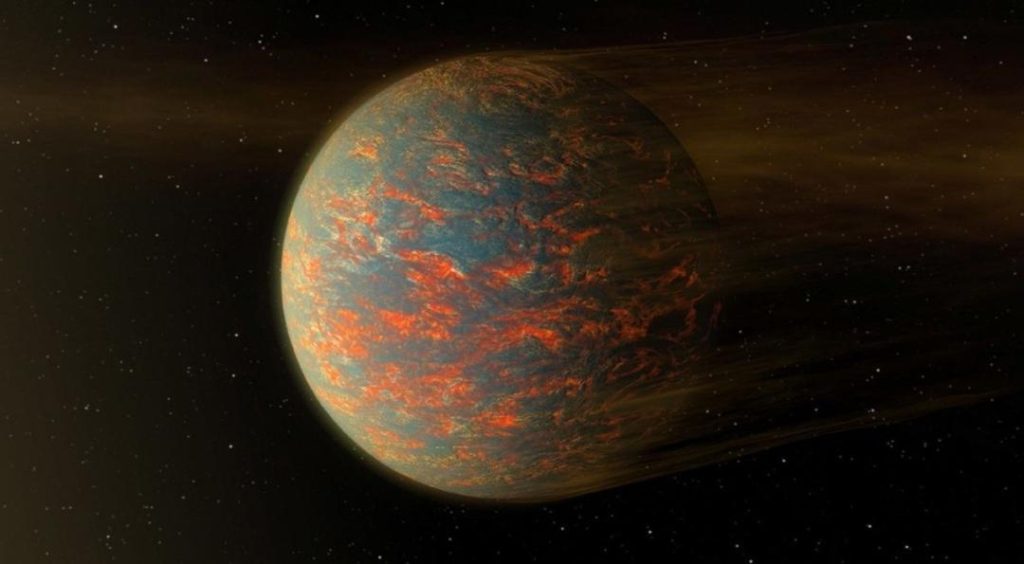
Newly-Discovered Super-Earth Heats Up & Freezes Every 300 Days
In a fascinating discovery, scientists have uncovered a new exoplanet that is unlike any other. This newly-discovered “super-Earth” is orbiting a Sun-like star 20 light-years from our planet, and its unique orbit takes it on a journey from extreme heat to extreme cold every 300 days. The findings have left astronomers intrigued and eager to learn more about this remarkable planet.
The planet, which has been classified as a “super-Earth,” is significantly larger than our own planet but smaller than the gas giants like Neptune and Uranus. This classification is based on its mass, which is between 2-10 times that of Earth. Super-Earths are of great interest to scientists because they offer a unique opportunity to study the formation and evolution of planetary systems.
Located in the constellation of Lyra, the newly-discovered super-Earth is orbiting a star that is remarkably similar to our own Sun. The star, known as K2-141b, is a G-type main-sequence star, which means it is a medium-sized star that is in the middle of its life cycle. The star is about 20% larger and 10% brighter than our Sun, making it an ideal candidate for hosting life-supporting planets.
The super-Earth, designated as K2-141b, orbits its star in an oval shape, which is known as an eccentric orbit. This unique shape means that the planet’s distance from its star varies greatly throughout its orbit. At its closest point, the planet is just 0.03 astronomical units (AU) from its star, while at its farthest point, it is about 0.45 AU away.
This eccentric orbit has a profound effect on the planet’s climate. For the first part of its year, K2-141b is extremely close to its star, causing it to experience scorching temperatures. The surface of the planet is likely to be a sizzling hot 3,000°F (1,600°C), making it one of the hottest planets ever discovered. This intense heat is likely due to the planet’s close proximity to its star, which means it receives an enormous amount of radiation and heat.
However, as the planet moves further away from its star, the temperature drops dramatically. The surface of K2-141b is likely to freeze at a chilling -200°F (-129°C), making it one of the coldest planets in the solar system. This extreme cold is likely due to the planet’s distance from its star, which means it receives very little radiation and heat.
This extreme temperature fluctuation is a unique feature of K2-141b and is unlike any other known exoplanet. The planet’s orbit is like a cosmic seesaw, with the temperature swinging wildly between extreme heat and extreme cold every 300 days.
The discovery of K2-141b was made possible by NASA’s Kepler space telescope, which has been monitoring the brightness of stars for signs of planets passing in front of them. The telescope has been instrumental in discovering thousands of exoplanets and has provided scientists with a wealth of information about the composition and orbit of these distant worlds.
The discovery of K2-141b is an exciting one for scientists because it offers a unique opportunity to study the formation and evolution of planetary systems. The planet’s extreme temperature fluctuation is likely to have a profound effect on its surface and atmosphere, making it an interesting target for future studies.
In conclusion, the discovery of K2-141b is a fascinating one that offers a unique glimpse into the diversity of planetary systems. The planet’s extreme temperature fluctuation is unlike any other known exoplanet and is a reminder of the vast and varied possibilities that exist in the universe. As scientists continue to study K2-141b and other exoplanets, we may uncover new and exciting insights into the formation and evolution of our universe.
News Source:
https://science.nasa.gov/universe/exoplanets/discovery-alert-super-earth-swings-from-super-heated-to-super-chill/






